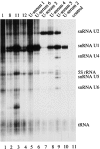Association of phosphorylated serine/arginine (SR) splicing factors with the U1-small ribonucleoprotein (snRNP) autoantigen complex accompanies apoptotic cell death
- PMID: 9463405
- PMCID: PMC2212144
- DOI: 10.1084/jem.187.4.547
Association of phosphorylated serine/arginine (SR) splicing factors with the U1-small ribonucleoprotein (snRNP) autoantigen complex accompanies apoptotic cell death
Abstract
Proteins subject to proteolysis or phosphorylation during apoptosis are commonly precipitated by autoantibodies found in the serum of patients with systemic lupus erythematosus (SLE). We screened a panel of murine monoclonal and human monospecific sera reactive with known autoantigens for their ability to selectively precipitate phosphoproteins from apoptotic Jurkat T cell lysates. Sera known to recognize the U1-small nuclear ribonucleoprotein (snRNP) complex (confirmed by their ability to precipitate U1-snRNA) selectively precipitated a phosphoprotein complex (pp54, pp42, pp34, and pp23) from apoptotic lysates. Monoclonal antibodies reactive with U1-snRNP proteins precipitated the same phosphoprotein complex from apoptotic lysates. The phosphorylation and/or recruitment of these proteins to the U1-snRNP complex is induced by multiple apoptotic stimuli (e.g., Fas ligation, gamma irradiation, or UV irradiation), and is blocked by overexpression of bcl-2. The U1-snRNP-associated phosphoprotein complex is immunoprecipitated by monoclonal antibodies reactive with serine/arginine (SR) proteins that comprise a structurally related family of splicing factors. The association of phosphorylated SR proteins with the U1-snRNP complex in cells undergoing apoptosis suggests a mechanism for regulation of alternative splicing of apoptotic effector molecules.
Figures












Similar articles
-
Human autoimmune sera as molecular probes for the identification of an autoantigen kinase signaling pathway.J Exp Med. 2002 Nov 4;196(9):1213-25. doi: 10.1084/jem.20021167. J Exp Med. 2002. PMID: 12417631 Free PMC article.
-
Small nucleolar RNP scleroderma autoantigens associate with phosphorylated serine/arginine splicing factors during apoptosis.Arthritis Rheum. 2000 Jun;43(6):1327-36. doi: 10.1002/1529-0131(200006)43:6<1327::AID-ANR15>3.0.CO;2-S. Arthritis Rheum. 2000. PMID: 10857791
-
The fate of the U1 snRNP autoantigen during apoptosis: implications for systemic autoimmunity.Isr Med Assoc J. 2002 Sep;4(9):706-12. Isr Med Assoc J. 2002. PMID: 12440236 Review.
-
Apoptotic modifications affect the autoreactivity of the U1 snRNP autoantigen.Autoimmun Rev. 2005 Jul;4(6):380-8. doi: 10.1016/j.autrev.2005.02.003. Epub 2005 Mar 23. Autoimmun Rev. 2005. PMID: 16081029 Review.
-
A U6 snRNA:pre-mRNA interaction can be rate-limiting for U1-independent splicing.Genes Dev. 1995 Sep 15;9(18):2314-23. doi: 10.1101/gad.9.18.2314. Genes Dev. 1995. PMID: 7557384
Cited by
-
An Autoantigen Profile of Human A549 Lung Cells Reveals Viral and Host Etiologic Molecular Attributes of Autoimmunity in COVID-19.bioRxiv [Preprint]. 2021 Feb 22:2021.02.21.432171. doi: 10.1101/2021.02.21.432171. bioRxiv. 2021. Update in: J Autoimmun. 2021 Jun;120:102644. doi: 10.1016/j.jaut.2021.102644. PMID: 33655248 Free PMC article. Updated. Preprint.
-
Preferential recognition of the phosphorylated major linear B-cell epitope of La/SSB 349-368 aa by anti-La/SSB autoantibodies from patients with systemic autoimmune diseases.Clin Exp Immunol. 2006 Jun;144(3):432-9. doi: 10.1111/j.1365-2249.2006.03088.x. Clin Exp Immunol. 2006. PMID: 16734612 Free PMC article.
-
Human autoimmune sera as molecular probes for the identification of an autoantigen kinase signaling pathway.J Exp Med. 2002 Nov 4;196(9):1213-25. doi: 10.1084/jem.20021167. J Exp Med. 2002. PMID: 12417631 Free PMC article.
-
Phosphorylated self-peptides alter human leukocyte antigen class I-restricted antigen presentation and generate tumor-specific epitopes.Proc Natl Acad Sci U S A. 2009 Feb 24;106(8):2776-81. doi: 10.1073/pnas.0812901106. Epub 2009 Feb 5. Proc Natl Acad Sci U S A. 2009. PMID: 19196958 Free PMC article.
-
A Streamlined Data Analysis Pipeline for the Identification of Sites of Citrullination.Biochemistry. 2021 Sep 28;60(38):2902-2914. doi: 10.1021/acs.biochem.1c00369. Epub 2021 Sep 7. Biochemistry. 2021. PMID: 34491035 Free PMC article.
References
-
- Astaldi-Ricotti G, Bestagno M, Cerino A, Negri C, Caporali R, Cobianchi F, Longhi M, Montecucco C. Antibodies to hnRNP core protein A1 in connective tissue diseases. J Cell Biochem. 1989;40:43–47. - PubMed
-
- Van Venrooij W, Sillekens P. Small-nuclear RNA-associated proteins: autoantigens in connective tissue diseases. Clin Exp Rheum. 1989;7:635–639. - PubMed
-
- von Muhlen CA, Tan EM. Autoantibodies in the diagnosis of systemic rheumatic diseases. Semin Arthritis Rheum. 1995;24:323–358. - PubMed
-
- Montecucco M, Caporali R, Negri C, deGennaro F, Cerino A, Bestagno M, Cobianchi F, Astaldi-Ricotti G. Antibodies from patients with rheumatoid arthritis and systemic lupus erythematosus recognize different epitopes of a single heterogeneous nuclear RNP core protein. Arthritis Rheum. 1990;33:180–186. - PubMed
Publication types
MeSH terms
Substances
Grants and funding
LinkOut - more resources
Full Text Sources
Other Literature Sources
Research Materials
Miscellaneous

